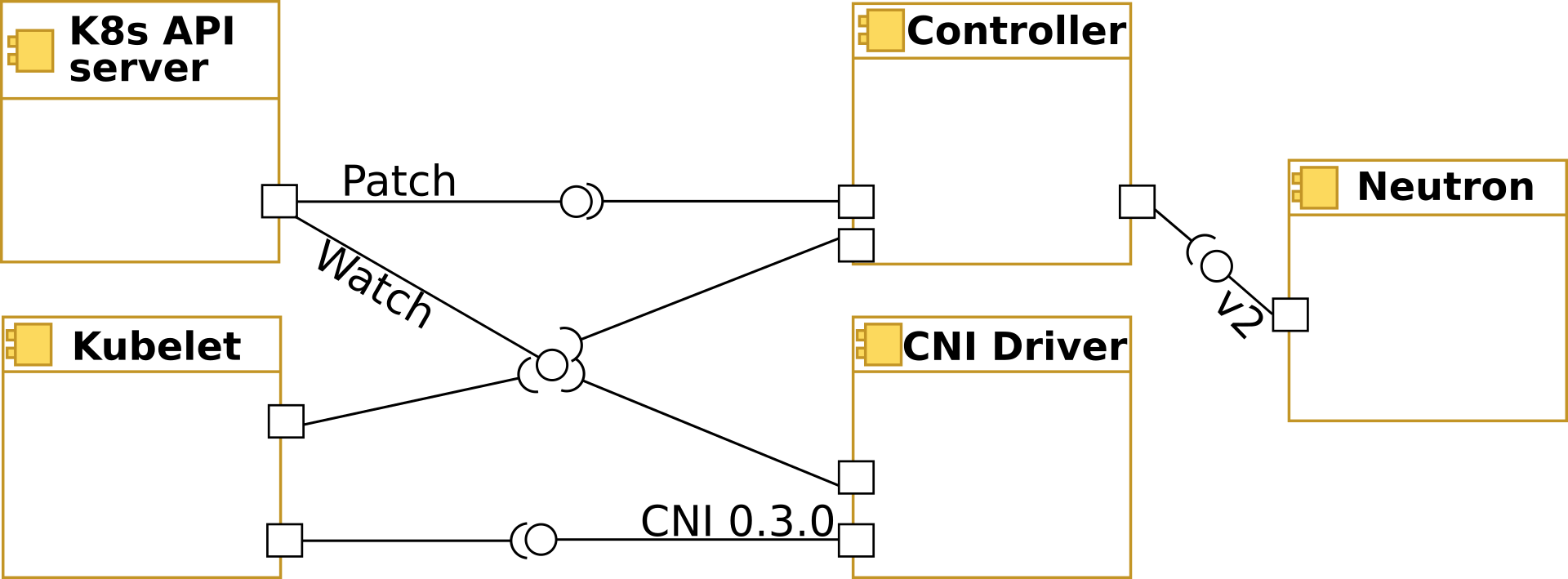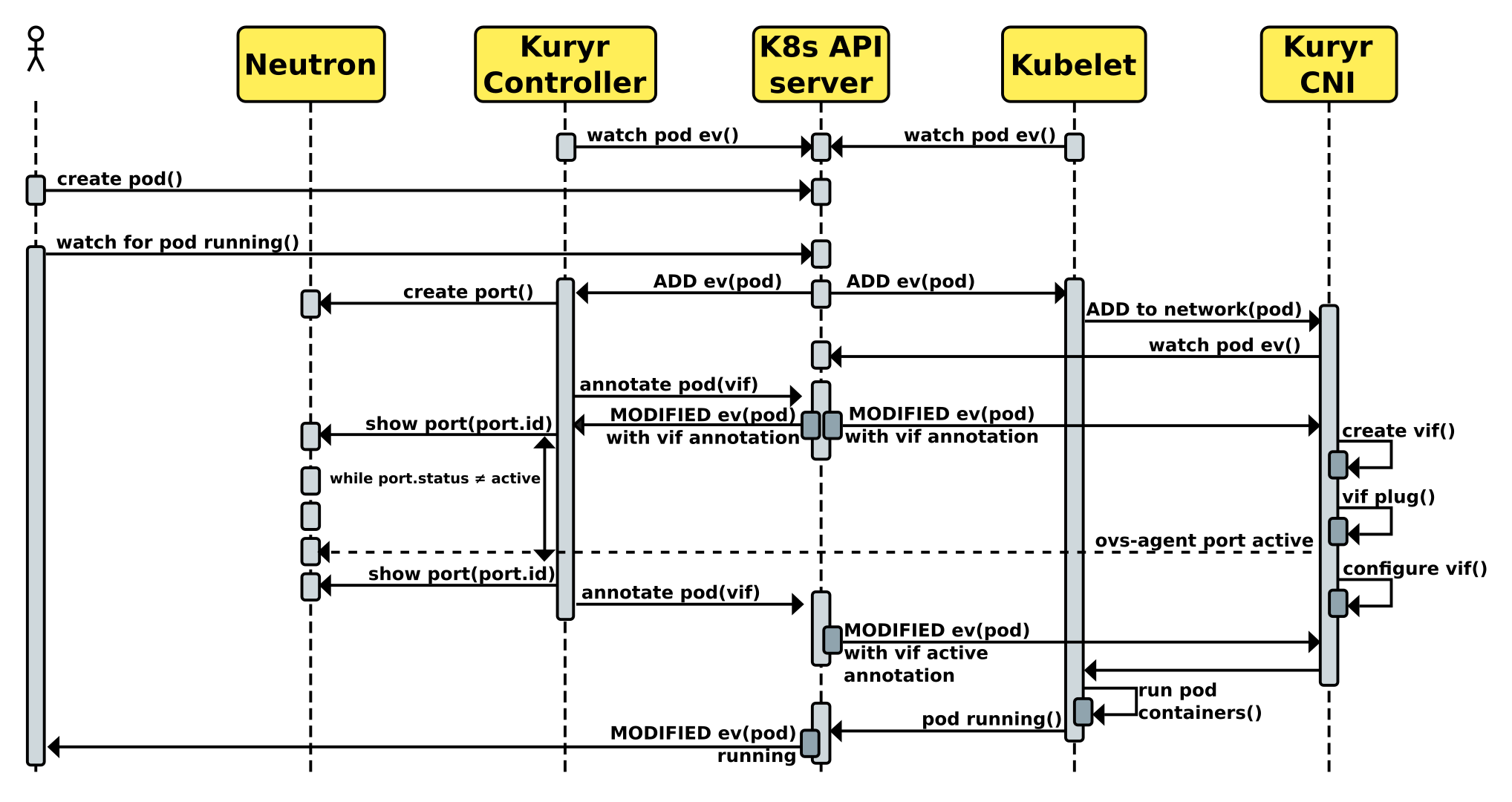Kuryr Kubernetes Integration Design¶
Purpose¶
The purpose of this document is to present the main Kuryr-K8s integration components and capture the design decisions of each component currently taken by the kuryr team.
Goal Statement¶
Enable OpenStack Neutron realization of the Kubernetes networking. Start by supporting network connectivity and expand to support advanced features, such as Network Policies. In the future, it may be extended to some other openstack services.
Overview¶
In order to integrate Neutron into kubernetes networking, 2 components are introduced: Controller and CNI Driver. Controller is a supervisor component responsible to maintain translation of networking relevant K8s model into the OpenStack (i.e. Neutron) model. This can be considered as a centralized service (supporting HA mode in the future). CNI driver is responsible for binding kubernetess pods on worker nodes into Neutron ports ensuring requested level of isolation. Please see below the component view of the integrated system:

Design Principles¶
- Loose coupling between integration components.
- Flexible deployment options to support different project, subnet and security groups assignment profiles.
- The communication of the pod binding data between Controller and CNI driver should rely on existing communication channels, currently added to the pod metadata via annotations.
- CNI Driver should not depend on Neutron. It gets all required details from K8s API server (currenltly through K8s annotations), therefore depending on Controller to perform its translation tasks.
- Allow different neutron backends to bind K8s pods without code modification. This means that both Controller and CNI binding mechanism should allow loading of the vif management and binding components, manifested via configuration. If some vendor requires some extra code, it should be handled in one of the stevedore drivers.
Kuryr Controller Design¶
Controller is responsible for watching Kubernetess API endpoints to make sure that the corresponding model is maintained in Neutron. Controller updates K8s resources endpoints’ annotations to keep neutron details required by the CNI driver as well as for the model mapping persistency.
Controller is composed from the following components:
Watcher¶
Watcher is a common software component used by both the Controller and the CNI driver. Watcher connects to K8s API. Watcher’s responsibility is to observe the registered (either on startup or dynamically during its runtime) endpoints and invoke registered callback handler (pipeline) to pass all events from registered endpoints.
Event Handler¶
EventHandler is an interface class for the K8s event handling. There are several ‘wrapper’ event handlers that can be composed to implement Controller handling pipeline.
Retry Event Handler is used for handling specified failures during event processing. It can be used to ‘wrap’ another EventHandler and in case of specified error will retry the wrapped event handler invocation within specified timeout. In case of persistent failure, Retry will raise the wrapped EventHandler exception.
Async Event Handler is used to execute event handling asynchronously. Events are grouped based on the specified ‘thread_groups’. Events of the same group are processed in order of arrival. Thread group maps to an unique K8s resource (each Pod, Service, etc.). Async can be used to ‘wrap’ another EventHandler. Queues per thread group are added dynamically once relevant events arrive and removed once queue is empty.
LogExceptions Event Handler suppresses exceptions and sends them to log facility.
Dispatcher is an Event Handler that distributes events to registered handlers based on event content and handler predicate provided during event handler registration.
ControllerPipeline¶
ControllerPipeline serves as an event dispatcher of the Watcher for Kuryr-K8s controller Service. Currently watched endpoints are ‘pods’, ‘services’ and ‘endpoints’. K8s resource event handlers (Event Consumers) are registered into the Controller Pipeline. There is a special EventConsumer, ResourceEventHandler, that provides API for K8s event handling. When a watched event arrives, it is processed by all Resource Event Handlers registered for specific K8s object kind. Pipeline retries on resource event handler invocation in case of the ResourceNotReady exception till it succeeds or the number of retries (time-based) is reached. Any unrecovered failure is logged without affecting other Handlers (of the current and other events). Events of the same group (same K8s object) are handled sequentially in the order arrival. Events of different K8s objects are handled concurenlty.

ResourceEventHandler¶
ResourceEventHandler is a convenience base class for the K8s event processing. The specific Handler associates itself with specific K8s object kind (through setting OBJECT_KIND) and is expected to implement at least one of the methods of the base class to handle at least one of the ADDED/MODIFIED/DELETED events of the k8s object. For details, see k8s-api. Since both ADDED and MODIFIED event types trigger very similar sequence of actions, Handler has ‘on_present’ method that is invoked for both event types. The specific Handler implementation should strive to put all the common ADDED and MODIFIED event handling logic in this method to avoid code duplication.
Providers¶
Provider (Drivers) are used by ResourceEventHandlers to manage specific aspects of the K8s resource in the OpenStack domain. For example, creating a K8s Pod will require a neutron port to be created on a specific network with the proper security groups applied to it. There will be dedicated Drivers for Project, Subnet, Port and Security Groups settings in neutron. For instance, the Handler that processes pod events, will use PodVIFDriver, PodProjectDriver, PodSubnetsDriver and PodSecurityGroupsDriver. The Drivers model is introduced in order to allow flexibility in the K8s model mapping to the OpenStack. There can be different drivers that do Neutron resources management, i.e. create on demand or grab one from the precreated pool. There can be different drivers for the Project management, i.e. single Tenant or multiple. Same goes for the other drivers. There are drivers that handle the Pod based on the project, subnet and security groups specified via configuration settings during cluster deployment phase.
NeutronPodVifDriver¶
PodVifDriver subclass should implement request_vif, release_vif and activate_vif methods. In case request_vif returns Vif object in down state, Controller will invoke activate_vif. Vif ‘active’ state is required by the CNI driver to complete pod handling. The NeutronPodVifDriver is the default driver that creates neutron port upon Pod addition and deletes port upon Pod removal.
CNI Driver¶
Kuryr kubernetes integration takes advantage of the kubernetes CNI plugin and introduces Kuryr-K8s CNI Driver. Based on design decision, kuryr-kubernetes CNI Driver should get all information required to plug and bind Pod via kubernetes control plane and should not depend on Neutron. CNI plugin/driver is invoked in a blocking manner by kubelet (k8s node agent), therefore it is expected to return when either success or error state determined.
Kuryr-K8s CNI Driver has 2 sources for Pod binding information: kubelet/node environment and K8s API. The Kuryr-K8s Controller Service and CNI share the contract that defines Pod annotation that Controller Server adds and CNI driver reads. The contract is os_vif VIF
With VIF object loaded from the Pod object annotation, the CNI driver performs Pod plugging. Kuryr-K8s CNI driver uses ov_vif library to perform Pod plug and unplug operations. The CNI driver should complete its job and return control to Kubelet when all the network plugging is completed. In the cases when Neutron initially creates port in ‘Down’ state, CNI driver will plug the Pod, but will have to watch the Pod annotations for vif state change to ‘Active’ before returning the control to the caller.

Kubernetes Documentation¶
The Kubernetes reference documentation is a great source for finding more details about Kubernetes API, CLIs, and tools.

Except where otherwise noted, this document is licensed under Creative Commons Attribution 3.0 License. See all OpenStack Legal Documents.